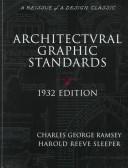Check nearby libraries
Buy this book

FOREWORD
The Foreword below was in the First and Second Editions of Architectural Graphic Standards; yet it is as true today as it was then. But there is a difference: today it is even more pertinent.
Watching the work of revision at the end of a five-year period I could not but be impressed with the far-flung field over which changes had already taken effect.
And so I puzzled over how much a book of this kind, because it contributes to the distribution of knowledge of new materials and new techniques, affects the rate at which our environment grows old and becomes
obsolete.
Frederick L. Ackerman
May, 1941
Twenty-five years ago, working drawings and specifications of important structures were turned out without reference to other than a few documents dealing with materials and the technique of fabrication and assembly. During the intervening period no less than a revolutionary change has taken place. The production of a competent set of drawings, today, necessitates reference to a vast amount of widely scattered information covering an endless list of materials and items of one sort and another—all of which involves highly specialized methods of production and assembly. Failure to produce drawings in conformity with current practice imposes a serious burden of additional cost without compensating gains.
This modern store of factual matter is too complex and extensive to be memorized. It is scattered through an endless number of books, pamphlets, reports, and documents of all sorts. Important facts are so deeply buried in the body of technical literature that they only come to light in the course of research. It follows that the architect or draughtsman is faced with the necessity of spending an ever-increasing amount of time in the gathering of information. The pressure of time often forces the making of assumptions and trusting to luck.
This book was designed in recognition of this condition; its very nature and scope constitute a full acknowledgment of the need. It is a serious attempt to confine within a book of reasonable dimensions the essential factual references required by the architect, draughtsman, and builder in the course of the day's work.
Obviously, such a work must be broad in scope; but it cannot possibly be all-inclusive. Its utility, therefore, must depend upon the experience and good judgment of the authors in the choice of factual material.
Graphic presentation is the language of the draughting room. This accounts for the absence of text. The plates, in many cases, constitute translation into this simple language of facts that are often obscured bywords.
*Frederick L. Ackerman
New York City March, 1936*
Check nearby libraries
Buy this book

Subjects
Architecture, Building, Details, Drawings, Standards, Graphic arts, Architecture, detailsShowing 7 featured editions. View all 7 editions?
Book Details
First Sentence
"Pin cut-out of small scale plan at center and revolve same until sun strikes at desired angles."
ID Numbers
Community Reviews (0)
Feedback?History
- Created April 29, 2008
- 5 revisions
Wikipedia citation
×CloseCopy and paste this code into your Wikipedia page. Need help?
| July 31, 2019 | Edited by MARC Bot | associate edition with work OL550046W |
| April 24, 2010 | Edited by Open Library Bot | Fixed duplicate goodreads IDs. |
| April 16, 2010 | Edited by bgimpertBot | Added goodreads ID. |
| April 14, 2010 | Edited by Open Library Bot | Linked existing covers to the edition. |
| April 29, 2008 | Created by an anonymous user | Imported from amazon.com record |











